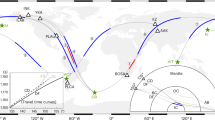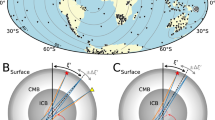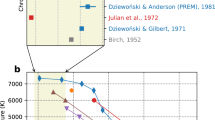Abstract
The finding that the Earth's inner core might be rotating faster than the mantle1 has important implications for our understanding of core processes, including the generation of the Earth's magnetic field2,3. But the reported signal is subtle—a change of about 0.01 s per year in the separation of two seismic waves with differing paths through the core. Subsequent studies of such data have generally supported the conclusion that differential rotation exists4,5,6, but the difficulty of accurately locating historic earthquakes7 and possible biases induced by strong lateral variations in structure near the core–mantle boundary8 have raised doubt regarding the proposed inner-core motion9. Also, a study of free oscillations10 constrained the motion to be relatively small compared to previous estimates and it has been proposed that the interaction of inner-core boundary topography and mantle heterogeneity might lock the inner core to the mantle11. The recent detection of seismic waves scattered in the inner core12 suggests a simple test of inner-core motion. Here we compare scattered waves recorded in Montana, USA, from two closely located nuclear tests at Novaya Zemlya, USSR, in 1971 and 1974. The data show small but coherent changes in scattering which point toward an inner-core differential rotation rate of 0.15° per year—consistent with constraints imposed by the free-oscillation data10.
This is a preview of subscription content, access via your institution
Access options
Subscribe to this journal
Receive 51 print issues and online access
$199.00 per year
only $3.90 per issue
Buy this article
- Purchase on Springer Link
- Instant access to full article PDF
Prices may be subject to local taxes which are calculated during checkout



Similar content being viewed by others
References
Song, X. D. & Richards, P. G. Seismological evidence for differential rotation of the Earth's inner core. Nature 382, 221–224 (1996).
Glatzmaier, G. A. & Roberts, P. H. A three-dimensional self-consistent computer simulation of a geomagnetic field reversal. Nature 377, 203–209 ( 1995).
Kuang, W. L. & Bloxham, J. An earthlike numerical dynamo model. Nature 389, 371–374 (1997).
Song, X. Joint inversion for inner core rotation, inner core anisotropy, and mantle heterogeneity. J. Geophys. Res. 105, 7931– 7944 (2000).
Creager, K. C. Inner core rotation rate from small-scale heterogeneity and time-varying travel times. Science 278, 1284– 1288 (1997).
Song, X. & Li, A. Support for differential inner core superrotation from earthquakes in Alaska recorded at South Pole station. J. Geophys. Res. 105, 623–630 ( 2000).
Poupinet, G., Souriau, A. & Coutant, O. The existence of an inner core super-rotation questioned by teleseismic doublets. Phys. Earth Planet. Inter. 118, 77–88 (2000).
Breger, L. & Romanowicz, B. Three-dimensional structure at the base of the mantle beneath the central Pacific. Science 282, 718–720 (1998).
Souriau, A., Roudil, P. & Moynot, B. Inner core differential rotation: Facts and artefacts. Geophys. Res. Lett. 24, 2103– 2106 (1997).
Laske, G. & Masters, T. G. Rotation of the inner core from a new analysis of free oscillations. Nature 402, 3397–3400 (1999).
Buffett, B. A. Geodynamic estimates of the viscosity of the Earth's inner core. Nature 388, 571–573 ( 1997).
Vidale, J. E. & Earle, P. S. Fine-scale heterogeneity in the Earth's inner core. Nature 404, 273– 275 (2000).
Green, P. E., Frosch, R. A. & Romney, C. F. Principles of an experimental large aperture seismic array (LASA). Proc. IEEE 53, 1821– 1833 (1965).
Capon, J. Analysis of Rayleigh-wave multipath at LASA. Bull. Seismol. Soc. Am. 60, 1701–1731 ( 1970).
Marshall, P. D., Porter, D., Young, J. B. & Peachall, P. A. Atomic Weapons Establishment Report O 2/94 (Her Majesty's Stationery Office, London, 1994).
Engdahl, E. R. & Felix, C. P. Nature of travel-time anomalies at Lasa. J. Geophys. Res. 76, 2706–2715 (1971).
Haddon, R. A. W., Husebye, E. S. & King, D. W. Origin of precursors to P′P′. Phys. Earth Planet. Inter. 14, 41– 70 (1977).
Earle, P. S. & Shearer, P. M. Observations of high-frequency scattered energy associated with the core phase PKKP. Geophys. Res. Lett. 25, 405–408 ( 1998).
Bhattacharyya, J., Shearer, P. M. & Masters, T. G. Inner core attenuation from short period PKP(BC) versus PKP(DF) waveforms. Geophys. J. Int. 114, 1–11 (1993).
Dziewonski, A. M. & Anderson, D. L. Preliminary reference Earth model. Phys. Earth Planet. Inter. 25 , 297–356 (1981).
Acknowledgements
We thank the Albuquerque Seismological Laboratory and B. Woodward and H. Bolton for access to LASA data. Discussions with K. Creager, P. Richards, T. Wallace, A. Souriau and P. Davis were helpful.
Author information
Authors and Affiliations
Corresponding author
Rights and permissions
About this article
Cite this article
Vidale, J., Dodge, D. & Earle, P. Slow differential rotation of the Earth's inner core indicated by temporal changes in scattering. Nature 405, 445–448 (2000). https://doi.org/10.1038/35013039
Received:
Accepted:
Issue Date:
DOI: https://doi.org/10.1038/35013039
This article is cited by
-
Multidecadal variation of the Earth’s inner-core rotation
Nature Geoscience (2023)
-
An initial map of fine-scale heterogeneity in the Earth’s inner core
Nature Geoscience (2022)
-
Localized temporal variation of Earth’s inner-core boundary from high-quality waveform doublets
Earthquake Science (2015)
-
Reconciling the hemispherical structure of Earth’s inner core with its super-rotation
Nature Geoscience (2011)
-
Chemical interaction of Fe and Al2O3 as a source of heterogeneity at the Earth's core–mantle boundary
Nature (2001)
Comments
By submitting a comment you agree to abide by our Terms and Community Guidelines. If you find something abusive or that does not comply with our terms or guidelines please flag it as inappropriate.



